“Long Range” Coyote Hunting with Short-Range Rifles
This article also appears in the January 2011 LongRangeHunting.com newsletter.
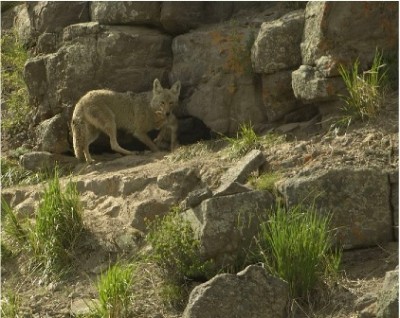
Figure 1. The Coyote, or canis latrans, is an important part of the ecosystem but whose numbers need management to avoid excessive predation on livestock Credit: www.LenBackus.com
You’re trudging out to your favorite coyote calling location in an area where cover is mostly sparse except for stream beds. The dry creek beds are frequently lined with trees and bushes providing plenty of cover for both you and your quarry. You’re carrying a 30-30 fitted with a scope like the Leupold 4X Wide Duplex sighted in on the mark at 100 yards. You’re using the rifle and scope because that’s what you have and conditions at the hide won’t let you see further than about 50 yards anyway.
About a quarter-mile from your hide, you top a ridge and see a pair of coyotes about 200 yards away. Can you take the shot? Can you be reasonably sure that you won’t miss and train the coyote to be more alert next time? Can you do it with confidence that the animal will be taken cleanly and not merely get wounded with the risk of a lingering death from infection or malnutrition?
You decide to forego the shot after a bit of soul-searching and go on to the hide wondering if you did the right thing.
How to be better prepared —
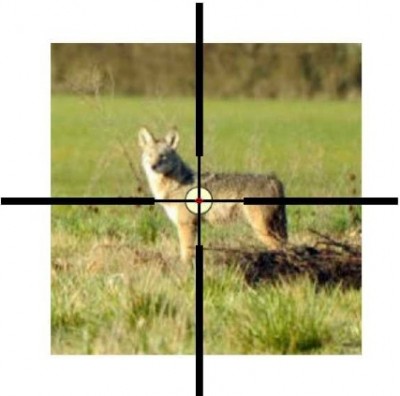
Figure 2. The shot as planned would have been an easy 50 yard or closer shot. Coyote picture credit: US Fish and Wildlife Service
As it happens, you can equip yourself with some mental tools that will help both to determine whether the shot would have been reasonable and to improve your chances of a clean kill if you did take the shot.
First, as a general rule of thumb, the principles for long range shooting are the same regardless of the firearm you use. Shooting becomes “long range” the moment you need to adjust or raise the sights or apply deflection for wind. For fixed sight weapons, the adjustments are frequently called Tennessee Elevation and Kentucky Windage. Historically, the fixed sight in early firearms made these techniques really necessary for many shots beyond 10 yards or so because the rear sight all too often was made by hand filing a groove on the receiver or on the hammer, but the principles remain valid even for adjustable sights.
Following three rules of thumb help keep the experience pleasant and successful:
The first is, as always, make sure that you follow both the letter and the spirit of safe shooting practices. Adhering to the spirit of safety will carry you through those few times when the details of safe practices momentarily escape your consciousness.
The second cardinal rule is: “Know your rifle and sighting equipment.” Important details are:
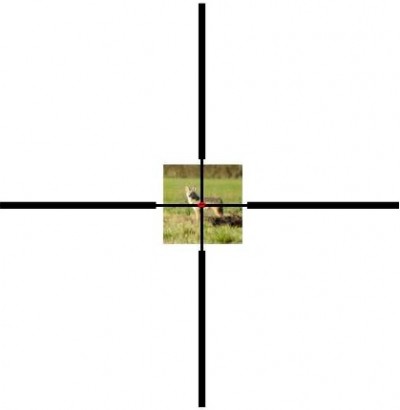
Figure 3. The 200 yd surprise, the coyote on the far hillside is a long way out for my 30-30. Should I take the shot? Coyote picture credit: US Fish and Wildlife Service
What is the maximum lethal range for your rifle and ammunition given your quarry and hunting objectives? Some would say that we’re going after coyotes and coyotes are varmints, right? So why not use any weapon that catches my fancy? The answer revolves around ethical hunting practices and being sure that we can get the pelt when appropriate. In both cases, we desire to make sure that we have margin for anchoring the animal quickly. This both prevents needless suffering and assures that the pelt is recoverable.
The third rule: Practice, practice, and more practice helps make rule number two real! In this context frequent shooting at both known and unknown ranges with your favorite coyote rifle and ammunition witht small targets will serve you well. The targets should approximate the coyote’s heart and lung area in size. Note how often you miss these targets in a variety of wind and weather conditions at the longer ranges. This will tell you how often you’ll lose the pelt by a poorly placed shot or outright miss!
Not all rifle and cartridge combinations provide adequate stopping power out to distances where one can reasonably get a hit in the vital zone. What do we mean by vital zone? The idea is the same as for large game, the heart and lung area is the biggest area where a solid hit will bring the animal down quickly. Hits to the brain and spine will also work, but these offer much smaller targets and misses will cause needless suffering.

Figure 4. Looking through the crosshair, we see that a 10 mph wind from the left causes the 150 gr 30-30 bullet to drift right with increasing distance. The ellipse indicates error caused by misjudging wind speed by only 2 mph!
One method for estimating stopping power is the Optimal Game Weight method. BigGameInfo.com has a page containing an extract from the Lyman #47 Manual discussing Optimal Game Weight and a table of typical weights of large game. Since an an adult Coyote weighs as much as 45 lb (more than ten times the weight of squirrels), their expression tells us:
- The 32 gr Remington Accutip needs more than 3100 ft/sec — Limits .204 Ruger to 200 yards when using this bullet.
- The 55 gr .223 bullet needs about 2150 ft/sec, keeping the range to under about 250 yards for most bullets
- Surprisingly, 150 gr 30-30 bullets need about 1100 ft/sec, giving it a lethal range of almost 400 yards.
The Optimal Game Weight method tells us that the bullet would likely do the job with a good hit even out to 400 yards. So, how likely are we to get a good hit as the range grows long?
Trajectory — Within what folks describe as the “point blank” range the flight of the bullet stays within the vital zone, subject to accuracy limitations. Outside this range, adjustments to windage and elevation need to be applied to get the bullet into the vital zone.
Furthermore, adjusting the zero to correct for range and current wind conditions is very difficult with most scopes used for 30-30 rifles. This means that Tennessee Elevation and Kentucky Windage both need to be used to get the bullet into the right part of the target at the longer ranges.
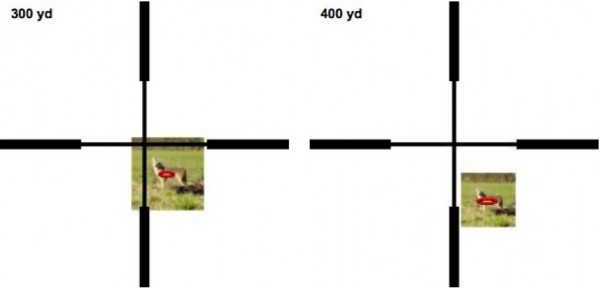
Figure 5. Sight picture needed to get center of impact on coyote vital zone at 300 and 400 yards when sighted-in on the mark at 100 yards. The red ellipse indicates where about half of the shots will hit with a 10 mph wind from the left and a wind-estimation error of 2 mph. Coyote picture credit: US Fish and Wildlife Service
Figure 5 above shows us that both the drift from a 10 mph wind and the drop at 300 and 400 yards make a precise shot very challenging. Furthermore, the uncertainty in wind drift means that we’ll have better than a 50-50 chance of only wounding the animal or missing it completely even when the offset and holdover are nominally correct. Hence the shot is questionable even though the bullet would be effective given a solid hit.
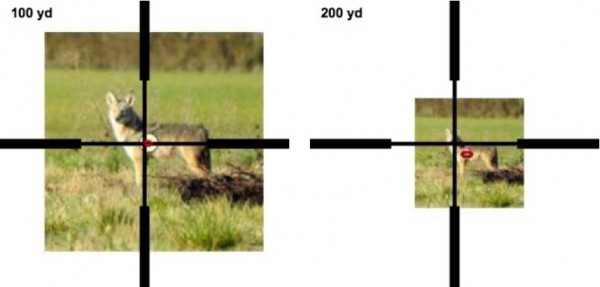
Figure 6. Sight picture needed to get center of impact on coyote vital zone at 300 and 400 yards. The red ellipse indicates where about half of the shots will hit with a 10 mph wind from the left and a wind-estimation error of 2 mph. Coyote picture credit: US Fish and Wildlife Service
Returning to our original question about the 200 yard shot, we see in Figure 6. that we likely could have taken the shot ethically even with a 10 mph wind. To be sure, we would want to offset our aim to account for wind drift and bullet drop, but we should be able to take a clean shot.
Many, if not most, scopes on 30-30 rifles today have duplex reticles. Among other things, these reticles help with range estimation. Note in Figure 6 that, 200 yards, the length of the Coyote’s body is about the same as the distance between the center post and the beginning of the thick section of the crosshair. We can see that, when the coyote is smaller than this, the distance is greater than 200 yards, and that we are not likely to be sure of an ethical shot.
Not all scopes are duplex and of precisely the same power as that illustrated here, so you will need to check the references for your scope. Practicing on small paper plates at appropriate distances will help develop your competence and improve your confidence. You’ll probably have some fun too!
Last, we ask how would these conclusions change if I went to, say, a bullet like the new 140 gr HornadyMonoflexload for the 30-30? As above, the plu or minus 2mph limitation in our assumed ability to judge and correct for wind drift controls the maximum ethical range. The 2500 ft/sec muzzle velocity and better ballistic coefficient, however, extends this limitation out to about 300 yards.
Not bad for an old Backwoods deer rifle!
###
Joe Smith is an avid shooter and reloader who has competed in the NRA 2700 matches (.22, .38, & .45 bullseye shooting) as well as international style air pistol. He has instructed rifle and shotgun skills for Boy Scouts of America shooting sports. He recently retired from the University of California after more than thirty years dedicated to research and development of a wide variety of weapons. He is a Vietnam Veteran and an NRA Life Member.

 sending...
sending...